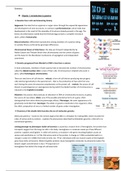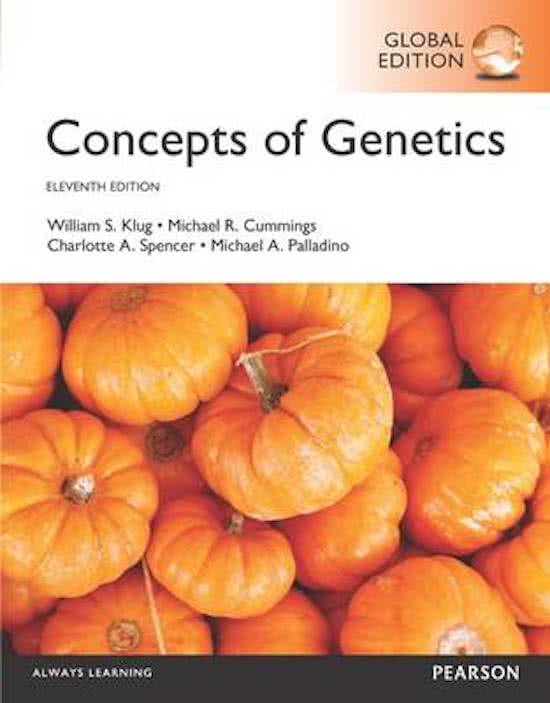Genetics
➔ Chapter 1: Introduction to genetics
→ Genetics has a rich and interesting history
Epigenesis: the idea that an organism or organ arises through the sequential appearance
and development of new structures, in contrast to preformationism, which holds that
development is the result of the assembly of structures already present in the egg. The
theory of preformation stated that the fertilized egg contains a complete miniature
adult, called a homunculus.
Natural selection: differential reproduction among members of a species owing
to variable fitness conferred by genotypic differences.
Chromosomal theory of inheritance: the idea put forward independently by
Walter Sutton and Theodor Boveri that chromosomes are the carriers of genes
and the basis for the Mendelian mechanisms of segregation and independent
assortment.
→ Genetics progressed from Mendel to DNA in less than a century
In most eukaryotes, members of each species have a characteristic number of chromosomes
called the diploïd number (2n) in most of their cells. Chromosomes in diploïd cells excist in
pairs, called homologous chromosomes.
There are two forms of cell division: - mitosis: a form of cell division producing two progeny
cells identical genetically to the parental cell – that is, the production of two cells from one,
each having the same chromosome complements as the parent cell. - meiosis: the proces of cell
division in gametogenesis or sporogenesis during which the diploïd number of chromosomes is
reduced to the haploïd (n) number.
Mutation: the process that produces an alteration in DNA or chromosome structure; in genes,
the source of new alleles. Allele: one of the possible alternative forms of a gene, often
distinguished form other alleles by phenotypic effects. Phenotype: the overt appearance of a
genetically controlled trait. Genotype: The allelic or genetic constitution of an organism; often,
the allelic composition of one or a limited number of genes under investigation.
→ Discovery of the double helix launches the era of molecular genetics
Molecular genetics – based on the central dogma that DNA is a template for making RNA, which encodes the
order of amino acids in proteins – explains the phenomena described by Mendelian genetics, referred to as
transmission genetics.
Linking genotype to phenotype: Sickle-cell anemia is caused by a mutant form of hemoglobin, the protein that
transports oxygen from the lungs to cells in the body. Hemoglobin is a molecule made up of two different
proteins: α-globin and β-globin. In sickle-cell anemia, a mutation in the gene encoding β-globin causes an
amino acid substitution in 1 of the 146 amino acids in the protein. A change in 1 DNA nucleotide leads to a
change in codon 6 in mRNA from GAG to GUG. Glu → Val. Individuals with two mutant copies of the β-globin
gene have sickle-cell anemia. Mutant β-globin proteins cause hemoglobin molecules to polymerize (when the
blood’s oxigen concentration is low ) → long chains of
hemoglobin that distort the shape of red blood cells.
1
,Genetics
→ Development of recombinant DNA technology began the era of DNA cloning
Recombinant DNA technology, a far-reaching methodology used in molecular genetics, allows genes from one
organism to be spliced into vectors and cloned, producing many copies of specific DNA sequences.
→ The impact of biotechnology is continually expanding
Biotechnology: commercial and/or industrial processes that utilize biological organisms or products.
Biotechnolgy has revolutionized agriculture, the pharmaceutical industry, and medicine. It has made possible
the mass production of medically important gene products. Genetic testing allows detection of individuals with
genetic disorders and those at risk of having affected children, and gene therapy offers hope for the treatment
of serious genetic disorders.
→ Genomics, proteomics, and bioinformatics are new and expanding fields
Genomics: studies the structure, function, and evolution of genes and genomes.
Proteomics: identifies a set of proteins present in cells under a given set of conditions. Studies their functions
and interactions.
Bioinformatics: uses hardware and software for processing nucleotide and protein data.
Reverse genetics: the DNA sequence for a particular gene of interest is known, but the role and function of the
gene are typically not well understood.
Genomics, proteomics, and bioinformatics are new fields derived from recombinant DNA technology. These
fields combine genetics with information technology and allow scientists to explore genome sequences, the
structure and function of genes, the protein set within cells, and the evolution of genomes. The Human
Genome Project is one example of genomics.
→ Genetic studies rely on the use of model organisms
The use of model organisms has advanced the understanding of genetic mechanisms and, coupled with
recombinant DNA technology, has produced models of human genetic diseases.
→ We live in the age of genetics
Society is faced with a host of sensitive genetics-relateted issues: → Prenatal testing → Ownership of genes →
Access to / safety of gene therapy.
The effects of genetic technolgy on society are profound, and the development of policy and legislation to deal
with issues derived from the use of this technology is lagging behind the resulting innovations.
2
,Genetics
➔ Chapter 2: mitosis and meiosis
Mitosis leads to the production of two cells, each with the same number
of chromosomes as the parent cell. In contrast, meiosis reduces the
genetic content and the number of chromosomes by precisely half.
Meiosis is part of a special type of cell division that leads to the
production of sex cells: gametes or spores (plants). When cells are not
undergoing division, the genentic material making up chromosomes
unfolds and uncoils into a diffuse network within the nucleus, generally referred to as chromatin.
→ Cell structure is closely tied to genetic function
All cells are surrounded by a plasma membrane, an outer covering that defines the cell boundary and delimts
the cell from its immediate external environment. Most animal cells have a covering over the plasma
membrane, referred to as the glycocalyx, or cell coat (glycoproteins and polysaccharides). Various receptor
molecules are also found on the surfaces of cells. The presence of a nucleus and other membranous organelles
is the defining chracteristic of eukaryotic organisms. The nucleus in eukaryotic cells is a membrane-bound
structure that houses the genetic material (DNA). The nucleolus is an amorphous component where ribosomal
RNA (rRNA) is synthesized and where the initial stages of ribosomal assembly occur. The portions of DNA that
encode rRNA are referred to as nucleolus organizer region (NOR). The remainder of the eukaryotic cell within
the plasma membrane, excluding the nucleus, is referred to as cytoplasm and includes a variety of extranuclear
cellular organelles. In the cytoplasm, a nonparticulate, colloidal material referred to as the cytosol surrounds
and encompasses the cellular organelles. The cytoplasm also includes microtubules, made of tubulin, and
microfilaments, which derive from the protein actin. The ER compartmentalizes the cytoplasm, greatly
increasing the surface area available for biochemical synthesis. Ribosomes serve as sites where genetic
information contained in mRNA is translated into proteins. Mitochondria are found in most eukaryotes,
including both animal and plant cells, and are the sites of the oxidative phases of cell respiration. Animal cells
and some plant cells also contain a pair of complex structures called centrioles. These cytoplasmic bodies, each
located in a specialized region called the centrosome, are associated with the organization of spindle fibers
that function in mitosis and meiosis.
→ Chromosomes exist in homologous pairs in diploid organisms
All somatic cells derived from members of the same species contain an identical number of chromosomes. In
most cases, this represents the diploid number (2n). With the exception of sex chromosomes, they excist in
pairs with the regard to these two properties, and the members of each pair are called homologous
chromosomes. → Exceptions: many bacteria and viruses have but one chromosome. Humans have a 2n
number of 46 chromosomes, this is displayed in a karyotype. The genetic information contained in a haploid
set of chromosomes constitutes the genome (includes noncoding DNA) of species. Homologous chromosomes
have important genetic similarities. They contain identical gene sites along their lengths; each site is called a
locus (pl. loci). Each diploid organism contains two copies of each gene as a consequence of biparental
inheritance, inheritance from two parents. In a population of members of the same species, many different
alternative forms of the same gene, called alleles, can excist.
Following fusion of two (haploid) gametes at fertilization, the diploid
number is reestablished. There is one important exception to the
concept of homologous pairs in chromosomes. In many species, one
pair, consisting of the sex-determing chromosomes, is often not
homologous in size, centromere placement, arm ratio, or genetic
content. → X and Y chromosomes in humans. Nevertheless, they
contain homologous regions and behave as homologs in meiosis.
3
, Genetics
→ Mitosis partitions chromosomes into dividing cells
Multicellular diploid organisms begin life as single-celled
fertilized eggs called zygotes. The genetic material is
partitioned into daughter cells during nuclear division, or
karyokinesis. Karyokinesis is followed by cytoplasmic
division, or cytokinesis. → Cytokinesis requires a mechanism
that partitions the volume into two parts, then encloses each
new cell in a distinct plasma membrane
The events that occur from the completion of one division until
the completion of the next division constitute the cell cycle
(see figure, see celbiologie for details (such as checkpoints)!).
Nomenclature (naamgeving) for location of genes is based on
chromosome number and G-banding.
→ Meiosis reduces the chromosome number from diploid to
haploid in germ cells and spores
Meiosis reduces the amount of genetic material
by half. Meiosis produces haploid gametes (or
spores), each containing one member of a
homologous pair of chromosomes. The meiotic
event referred to as crossing over results in
genetic exchange between members of each
homologous pair of chromosomes. Meiosis is
the major source of genetic recombination
within species.
In mitosis: each paternally and maternally derived member of any
given homologous pair of chromosomes behaves autonomously
during division. In meiosis: homologous chromosomes form pairs;
that is, they synapse (or undergo synapsis).
Bivalents: synapsed homologous chromosomes in the first prophase
of meiosis.
Tetrad: the four chromatids that make up paired homologs in the prophase of
the first meiotic division. In eukaryotes with a predominant haploid stage, a
tetrad denotes the four haploid cells produced by a single meiotic division.
To achieve haploidy, two divisions are necessary: reductional division (meiosis
1 → the number of centromeres, each representing one chromosome, is
reduced by one-half) & equational division (meiosis 2 → the number of
centromeres remains equal).
Dyad: the products of tetrad separation or disjunction at meiotic prophase 1.
Each dyad consists of two sister chromatids joined at the centromere.
Monads:during equational division, each dyad splits into two monads of one
chromosome each.
4





